Common Plant Diseases
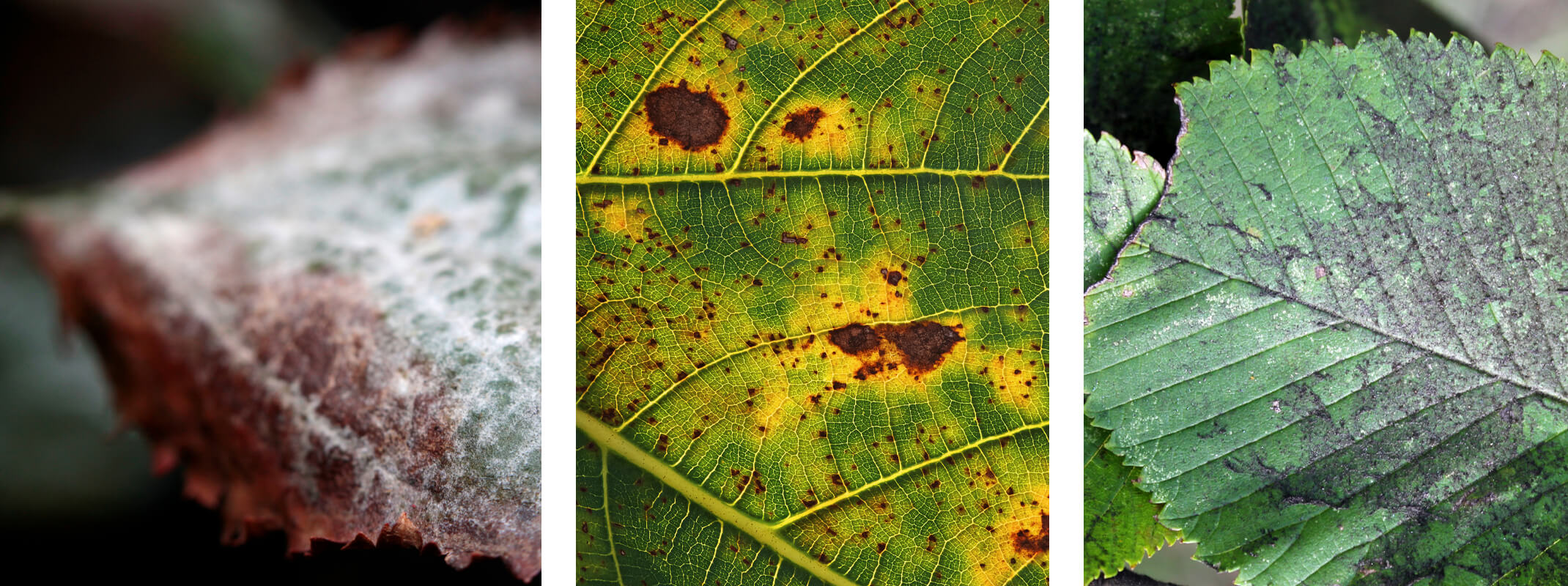 Guide to Common Plant Diseases
Guide to Common Plant Diseases
Plant diseases and fungi can be tricky to treat because they spread through microscopic spores that can travel on a breeze or lay dormant over winter, ready to strike once the temperatures rise. Treating them early is key to reducing the damage and spread. Remember to permanently dispose of diseased plant parts in the garbage, not the compost bin, and sanitize your shears with disinfectant before and after making cuts.
Phytophthora Root and Crown Rot
This disease affects pretty much all fruit and nut trees, plus many ornamental trees, shrubs, tomatoes, peppers, eggplants, and even some common California native plants. It occurs in warm soil that has been moist for too long or along the stems of plants that have been planted too deeply in damp soil.
How to Spot It
Symptoms of phytophthora root and crown rot include:
- Browning of the outer layer of sapwood
- Noticeably stressed out leaves
- Rapid wilting or death as the warmer spring weather sets in
- Leaves turning dull green, yellow, or sometimes even reddish purple
- A visible change in color and texture in one branch or stem that gradually spreads through the rest of the plant
How to Deal with It
Maintaining good soil drainage can help prevent a number of diseases, but it’s especially important for preventing root and crown rot. Try not to water your trees directly on their trunk or allow too much moisture to pool around the base. If you use sprinklers, make sure they are positioned at a low angle and won’t spray the base of your plant directly. If you’re using drip irrigation, place the emitters a foot or two away from the trunk. When planting your trees, shrubs, and vegetable starters, don’t bury their stems deeply or pile up dirt around the base.
Peach Leaf Curl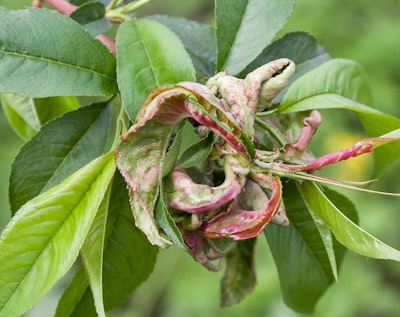
How to Spot It
Peach trees and other related fruit trees, like nectarines, are susceptible to this disease. It progresses in 4 stages:
- 1) It appears in spring and causes leaves to develop red patches.
- 2) The red patches thicken, curl up and warp the shape of the leaf.
- 3) They turn yellowish-brown and will either stay on the branch or fall off.
- 4) The tree will produce a new set of replacement leaves that may or may not become affected by the disease, depending on whether you treat it properly.
While the tree will end up producing replacement leaves, it still ends up draining energy from the plant that would otherwise be spent on producing tasty fruit.
How to Deal With It
Copper fungicides are the best treatment for peach leaf curl, but they’re best used in winter during the dormant season. You’ve got to space out the applications properly, at least 30 days apart when the trees are still leafless. To save you the trouble of doing complicated calendar math, mark down these dates for fungicide application. They’re timed out perfectly and easy to remember:
- December 1st
- New Year’s Day
- Valentine’s Day
Follow these tips to make sure it works properly:
- Use a copper fungicide 24 hours before you follow up with horticultural oil.
- Apply it in the morning on a dry day that isn’t too windy, with no expected rain for at least 24 hours.
- Never apply copper fungicide if the leaf buds have already opened up. Make sure you apply it while they’re still closed.
Sooty Mold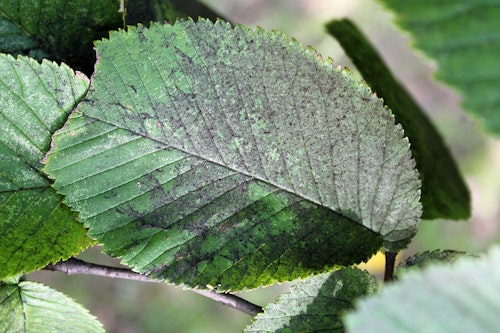
How to Spot It
This is the powdery, dark fungus resulting from honeydew left behind by bugs like aphids and whiteflies. While it doesn’t actually infect the plant, it blocks the sun from reaching the leaves, which messes with the plant’s ability to photosynthesize.
How to Deal With It
Use the appropriate insect control method to deal with whatever pests are leaving the honeydew droppings all over your plants. Cut out affected plant parts with disinfected shears, and dispose of the cuttings in the garbage. Spray with Bonide's Neem Oil.
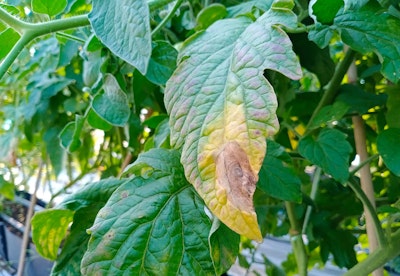 Early Blight
Early Blight
How to Spot It
You will start to see damage on the oldest foliage first. The affected leaves will have brown circular like lesions. Those leaves severely infected will turn yellow and drop off.
How to Deal With It
By maintaining optimum growing conditions: regular fertilization, watering, and management of pests, Early Blight can be minimized. Bonide Copper Fungicide is also effective.
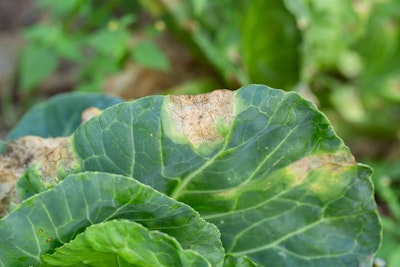 Downy Mildew
Downy Mildew
How to Spot It
Downy mildew will appear on leaves as small, light green to yellow spots and will remain in-between the veins of the leaf. The spots will eventually merge and turn brown. Older leaves will become infected first.
How to Deal With It
Look for varieties that are resistant to downy mildew. Avoid overhead irrigation. Watch for downy mildew during the vegetative growth stage through the production of fruit. Apply Monterey’s Garden Phos when symptoms first occur.
Blossom-End Rot
How to Spot It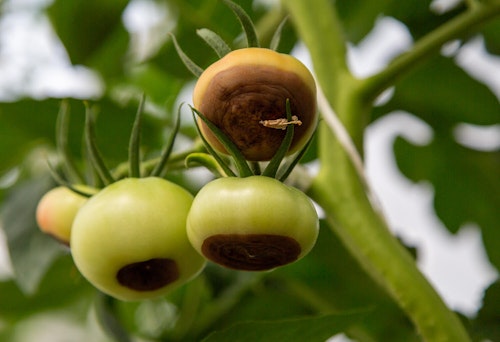
Blossom-end rot occurs due to a deficiency of calcium. You’ll see this more often when the tomato plants grow rapidly during the early part of the season and are subject to hot dry weather, when the fruits are in an early stage. Too much water, flushing through the soil may also cause the problem. Symptoms first appear as though the fruit it water soaked at bottom of the fruit. The spot will become brown and enlarge, and eventually turn leathery and sunken.
How to Deal With It
Once the problem exists, there is no curing it. However, the disorder can be avoided by using best practices. Be careful to avoid heavy applications of nitrogenous fertilizer and excess watering. Fertilizer for tomato plants should contain a balance of phosphorus and nitrogen. We recommend, E.B. Stone Organics Tomato and Vegetable Food. Another best practice includes using mulch around the base of the plants to reduce the loss of moisture from the soil. Bonide Tomato & Vegetable Spray or Maxi Cal, Bonide Rot-Stop® – created specifically for blossom-end rot will also help.
Fire Blight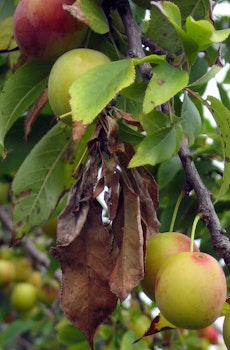
How to Spot It
Apple and pear trees are most commonly affected by this destructive disease, and the first signs can appear as soon as the trees begin their spring growth spurt. Fire blights first appear as oozing cankers on branches, twigs, and trunks. The ooze turns dark from air exposure, leaving streaks on the bark. These cankers are small and may be difficult to see in their early stages.
As the infection worsens, flowers, fruits, and stems will blacken and shrivel, looking like they got torched with fire. That’s why they call it fire blight! Open flowers are the most vulnerable to infection, but the disease can also spread through the branches, trunk, and root systems. Fire blight can eventually kill the tree if left untreated. To see if fire blight has spread through the wood of your tree, chip a bit of the bark away near an active canker. If the wood underneath has pink or orangey-red streaks, the blight is spreading.
How to Deal With It
Specific temperature and weather conditions create the ideal environment for fire blight to make an appearance. 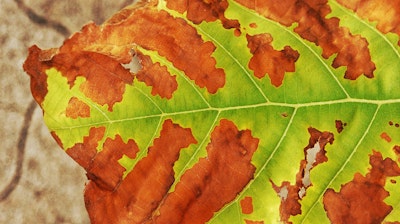 When the temperature is hovering around 75°–85°F, with heavily humid weather or rain, this can be a recipe for a fire blight outbreak. Be on high alert for signs of fire blight on your apple and pear trees when the weather is warm and damp. Apply copper fungicide in late winter to help build up your tree’s defense against fire blight. Avoid irrigating your tree while it’s actively blooming, avoid heavy pruning between March and December, and don’t use fertilizers with high levels of nitrogen. Pruning damaged pieces off before they spread can help your tree bounce back from fire blight, but it spreads rapidly and can kill the tree if you don’t deal with it quickly. And finally, you can apply Monterey's Garden Phos.
When the temperature is hovering around 75°–85°F, with heavily humid weather or rain, this can be a recipe for a fire blight outbreak. Be on high alert for signs of fire blight on your apple and pear trees when the weather is warm and damp. Apply copper fungicide in late winter to help build up your tree’s defense against fire blight. Avoid irrigating your tree while it’s actively blooming, avoid heavy pruning between March and December, and don’t use fertilizers with high levels of nitrogen. Pruning damaged pieces off before they spread can help your tree bounce back from fire blight, but it spreads rapidly and can kill the tree if you don’t deal with it quickly. And finally, you can apply Monterey's Garden Phos.
Powdery Mildew
How to Spot It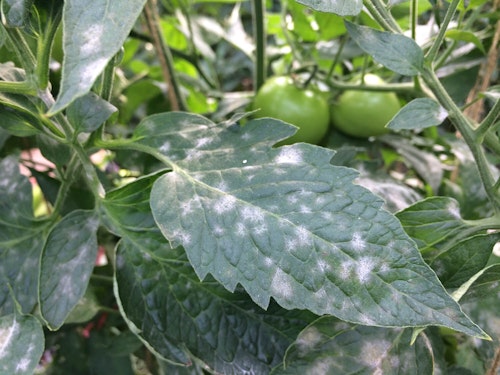
Powdery mildew is a fungus that coats your plants with a white powder, just like a jelly donut. It can affect old growth or new growth, usually on leaves and shoots, but sometimes on fruits and flowers. It’s a pretty common fungus and affects all sorts of different garden plants; however, many different strains only target specific types of plants. This means the type of powdery mildew that affects cucurbits, like melons and squashes, is a totally different kind than the powdery mildew that affects roses. In other words, you don’t have to worry about one strain wiping out your entire garden.
How to Deal With It
Powdery mildew will often appear if there isn’t enough air circulation between your plants’ leaves. If you water them overhead, or if there’s a heavy rain and water collects between the leaves and doesn’t evaporate, mildew may start to form. Prevent it by thinning dense foliage with pruning shears, adequately spacing out your plants, planting them in full sun (if appropriate), and watering them at the soil level instead of overhead.
Some ornamentals like roses and crape myrtles are super vulnerable to powdery mildew, so using a copper fungicide at the beginning of the season is a good idea. Remember to remove all the diseased plant parts with sanitized shears and dispose of them in the trash to stop the spread. Spray with Bonide's Neem Oil.
Botrytis Blight/Botrytis Cinereal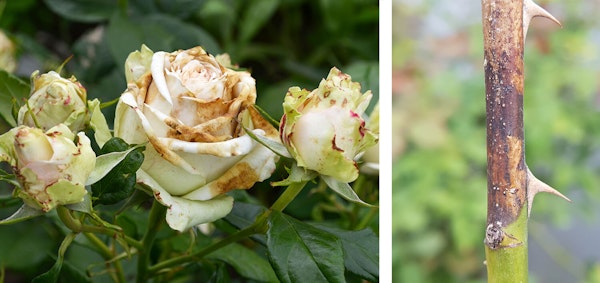
How to Spot It
This fungus pops up in humid weather and causes flowers to develop spots and discoloration. The flower buds, leaves, and shoots will rot, decay, and drop. Greyish-brown spore masses indicate an infection, but sometimes it may also cause bright magenta splotches. In bad cases, twigs may fall off, and buds won’t open.
How To Deal With It
Thin out the branches to promote air circulation, avoid watering overhead, and remove all diseased plant parts with sanitized shears. Dispose of any old branches or debris that might be hanging around the plant. Keep your plants consistently watered and fertilized to keep them strong so they’re better able to resist infection.
Black Spot/Diplocarpon Rosae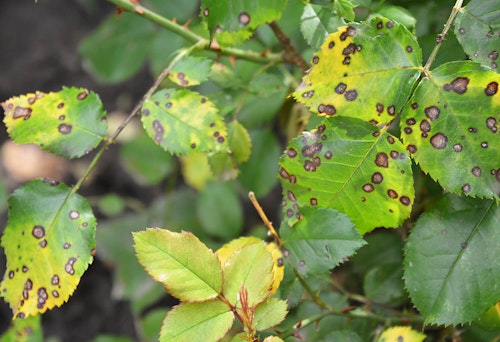
How to Spot It
Black spot affects roses, and it appears as—you guessed it—black spots. The areas around the black spots will turn yellow, and infected leaves may drop. It thrives in humid climates or dark, damp areas. Sometimes the black spots have feathery margins or tiny, fungal fruiting bodies sticking out.
How to Deal With It
Put these prevention tips into practice when growing roses to ensure they grow healthy and aren’t vulnerable to disease:
- Water early in the morning so the excess moisture evaporates from the sun before nightfall. Try to rinse off aphids if you see any.
- Provide adequate space between your rose bushes.
- Thin dense foliage to improve air circulation.
- Dispose of fallen leaves and branches that have collected around the roses.
- Plant roses in a spot with 6–8 hours of direct sun per day.
- Use copper fungicide.
- Prune off infected stems in winter.
- Try to choose disease-resistant rose varieties.
Rusts/Various Fungi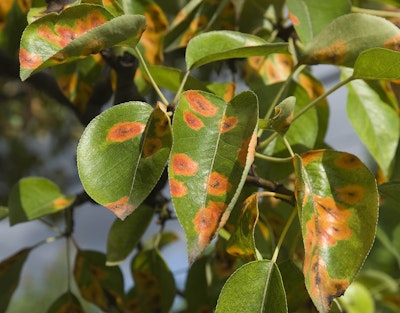
How to Spot It
Rust likes to make an appearance during cool, moist weather, so it’s a bit of an issue here on the coast. It can also develop in inland regions during particularly rainy periods. Leaves will get orangey-brown spots, and the leaves will eventually turn yellow or brown and will fall off early. While many rust problems can be treated easily with few side effects to your plants, severe rust can kill a plant. Environmental conditions and the nearness of other plants infected with rust will affect the severity of the case.
How to Deal With It
Prune off severely infected areas and apply a Bonide Copper Fungicide. Avoid overhead watering, and remember to collect and dispose of any leaves or branches that may have collected around your plants.
Sudden Oak Death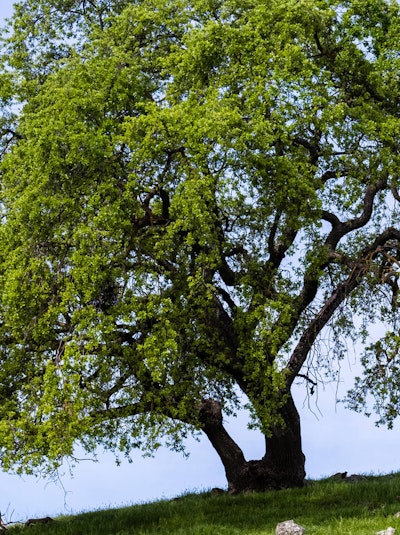
Over 1 million oak and tanoak trees have been killed in California over the past decade due to this invasive pathogen, Phytophthora ramorum. There are two categories of hosts for P. ramorum: trunk hosts and foliar hosts. Trunk hosts, like oaks and tanoaks, contract the infections through their bark. The infections are often fatal—plus, they also attract all sorts of other pathogens and pests that can further harm your trees. Foliar hosts, like bay laurel, contract the disease through their leaves and are usually the ones to blame when the pathogen is spreading.
How to Spot It
It’s kind of tricky to identify sudden oak death because the signs can look a lot like other ailments such as root and crown rot, boring insect infestations, wetwood bacteria, damage from improper irrigation, or even physical injury. However, if you suspect P. ramorum is the culprit, you can seek out a confirmed diagnosis.
Foliar hosts require foliar sampling, and you can do this by removing about ten affected leaves and submitting them for analysis. Contact your local Cooperative Extension or County Agricultural Commissioner’s office for more information on how sampling is performed in your area. Bark sampling for oaks and tanoaks is a trickier process. It’s a bit of a delicate process; it’s invasive and requires special equipment, so we recommend you enlist the help of a trained sampler.
How to Deal With It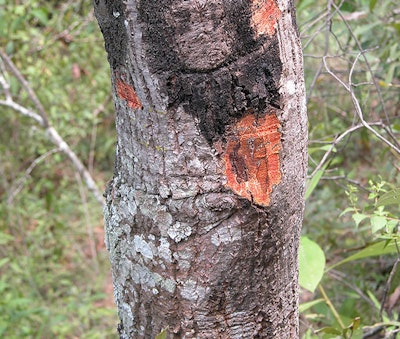
The bad news is that sudden oak death can’t be cured. However, it doesn’t always mean you have to cut down your trees. Foliar hosts, like bay laurel, are much more likely to spread the infection around, so it’s essential to remove these plants ASAP. Infected oaks may remain relatively healthy for several years and don’t need to be removed right away. That being said, the removal process for an infected tree is different than that of a regular tree, so you’ll definitely want to hire professionals to help.
To prevent the spread of P. ramorum, it’s a good idea to inspect any new plants you bring home. Many common garden plants can have P. ramorum spores lurking within them, and when they get shipped across the country, they can introduce the disease to new areas. Plant shipping is a strictly regulated practice, and SummerWinds Nursery is diligent about proper shipping practices and working with trusted buyers. Feel free to ask us for details about the measures we have in place to prevent sudden oak death.
The Solutions...
Bonide Copper Fungicide
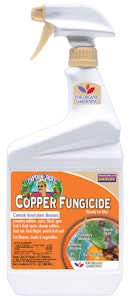

Controls powdery mildew, downy mildew, black spot, peach leaf curl, rust, and other listed diseases. Perfect for use on vegetables, roses, fruits, nuts, herbs, ornamentals, and turf. Incredibly easy to apply and can be used up to the day of harvest.
- Controls insects and diseases by suffocation
- Controls listed plant diseases using low concentrations of copper
- Approved for organic gardening
- Dormant and growing season applications
- Controls powdery mildew, black spot, rust, downy mildew and more
- Also controls Fruit Rot, Late Blight, Peach Leaf Curl and more
Bonide All Seasons Horticultural Spray Oil
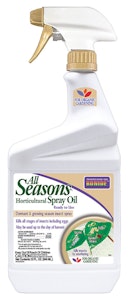

For organic gardening. A superior type of paraffinic oil that may be used as a growing season spray, dormant spray (no leaves) or delayed dormant (green tip) spray to control overwintering eggs of red spiders, scale insects, aphids, bud moths, leaf roller, red bug, codling moth, blister mites, galls, whitefly, mealy bugs and other insects and diseases. Highly recommended for use on fruit trees, shade trees, shrubs, ornamentals, roses, and vegetables. Safe and pleasant to use.
- Controls insects and diseases by suffocation
- Approved for organic gardening
- Dormant and growing season horticultural oil
- Formulated with paraffinic oil to smother insects on listed plants
- Kills insects and their overwintering eggs
Bonide Captain Jack's™ Neem Oil
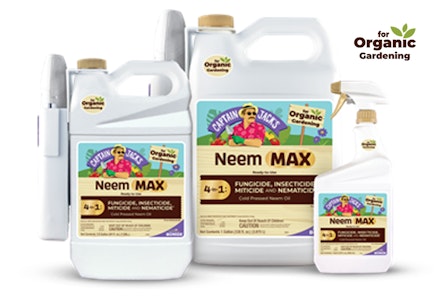

An all-purpose insecticide, miticide, and fungicide for organic gardening that is derived from the Neem seed, it can be used on roses, flowers, vegetables, herbs, spices, houseplants, trees, turf and shrubs. Kills all stages of insects including eggs, larvae, and adults.
- Controls insects, diseases and mites
- Approved for organic gardening
- Kills insect eggs, larvae and adults
- Controls black spot, powdery mildew, rust and more
- Kills mites, aphids, whiteflies and more
Bonide Tomato & Vegetable 3-in-1
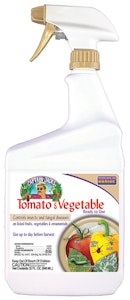

This product is designed to kill species of aphid, spider mite, ant, cricket, weevil, caterpillar, fly, thrip, silverfish, & more. Tomato & Vegetable spray controls blackspot, powdery mildew, rust, scab, blight, brown rot, & leaf spot. For best control apply as a protective spray early in the season before the diseases are noticed. Our insect killer is perfect for use on listed fruits, vegetables, & ornamentals. This includes beans, beets, carrots, cabbage, kale, onions, tomatoes, roses, houseplants, shrubs, almonds, apples, pears, & more. This product is conveniently ready to use when it arrives at your home. The spray nozzle makes this product easy to deploy.
- Controls both insects and fungal disease on vegetables, fruits and ornamentals
- Use up to the day of harvest
- Controls blight, leaf spot, blackspot and other
Monterey Garden Phos
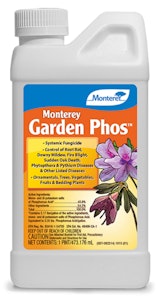
- For effective control of:
- Phytophthora diseases associated with Sudden Oak Death (SOD)
- Downy mildew, phytophthora & pythium in ornamentals & bedding plants
- Pythium in turf

